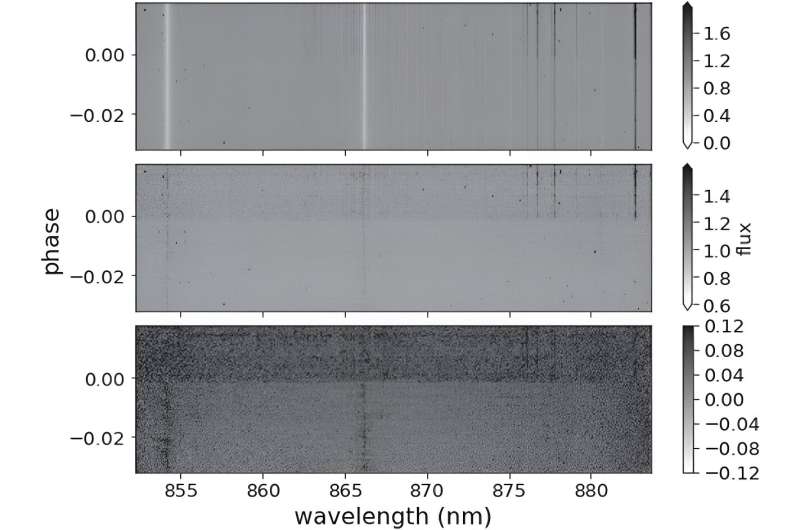This article has been reviewed according to Science X's editorial process and policies. Editors have highlighted the following attributes while ensuring the content's credibility:
fact-checked
peer-reviewed publication
trusted source
proofread
'Thermometer' molecule confirmed on exoplanet WASP-31b

Chromium hydride (CrH), a molecule that's relatively rare and particularly sensitive to temperature, is useful as a "thermometer for stars," according to astronomer Laura Flagg, because it's abundant only in a narrow range between 1,200–2,000 degrees Kelvin.
Flagg, a research associate in astronomy in the College of Arts and Sciences (A&S), has used this and other metal hydrides to determine the temperature of cool stars and brown dwarfs. In theory, she said, chromium hydride could do the same for hot Jupiter exoplanets, which are comparable in temperature to brown dwarfs—if these particular molecules are present in exoplanet atmospheres. Previous research, at low resolution, hinted that they are.
Now, Flagg and a Cornell-led team of researchers have confirmed, using high-resolution spectral observations, the presence of chromium hydride in an exoplanet atmosphere of the hot Jupiter WASP-31b, opening the door to use this temperature-sensitive molecule species as a "thermometer" to determine the temperature and other characteristics in exoplanets.
Flagg is lead author of "ExoGemS Detection of a Metal Hydride in an Exoplanet Atmosphere at High Spectral Resolution," published in The Astrophysical Journal Letters.
Chromium hydride has no previous confirmed detections in any exoplanet, and this marks the first detection of a metal hydride from a high-resolution exoplanet spectrum, the researchers wrote.
The definitive detection of metal hydrides in WASP-31b is an important advancement in the understanding of hot giant planet atmospheres, Flagg said, although the discovery doesn't give new information about the individual planet. Discovered in 2011, WASP-31b orbits an F5 star once every 3.4 days. It has an extremely low density, even for a giant planet, and the new study confirms its equilibrium temperature at 1,400 Kelvin—in range for chromium hydride.
"Chromium hydride molecules are very temperature sensitive," Flagg said. "At hotter temperatures you see just chromium alone. And at lower temperatures it turns into other things. So there's only a specific temperature range, about 1,200 to 2,200 Kelvin, where chromium hydride is seen in large abundances."
In our solar system, the only detected occurrence of this molecule is in sunspots, Flagg said, the sun is too hot (around 6,000 K on the surface) and all other objects are too cool.
In her research, Flagg uses high-resolution spectroscopy to detect and analyze exoplanet atmospheres, comparing the overall light from the system when the planet is to the side of the star against when the planet is in front of the star, blocking some of the star's light. Certain elements block more light at certain wavelengths and less light at other wavelengths, revealing what elements are in the planet.
"High spectral resolution means we have very precise wavelength information," Flagg said. "We can get thousands of different lines. We combine them using various statistical methods, using a template—an approximate idea of what the spectrum looks like—and we compare it to the data and we match it up. If it matches well, there's a signal. We try all the different templates, and in this case the chromium hydride template produced a signal."
Chromium is rare, even at the right temperature, so researchers need sensitive instruments and telescopes, Flagg said.
To analyze WASP-31b, the researchers used high-resolution spectra from one new observation in March 2022 as part of the Exoplanets with Gemini Spectroscopy survey from Hawaii's Maunakea, using Gemini Remote Access to CFHT ESPaDOnS Spectrograph (GRACES). They supplemented the GRACES data with archival data taken in 2017, which was not intended to look for metal hydrides.
"Part of our data for this paper was old data that was on the very edge of the data set. You wouldn't have looked for it," Flagg said. She is now on the lookout for chromium hydride and other metal hydrides in other exoplanets—and the evidence may already exist.
"I'm hoping that this paper will encourage other researchers to look in their data for chromium hydride and other metal hydrides," Flagg said. "We think it should be there. Hopefully we'll get more data that will be suitable for looking for chromium hydride and eventually build up a sample size to look for trends."
More information: Laura Flagg et al, ExoGemS Detection of a Metal Hydride in an Exoplanet Atmosphere at High Spectral Resolution, The Astrophysical Journal Letters (2023). DOI: 10.3847/2041-8213/ace529
Journal information: Astrophysical Journal Letters
Provided by Cornell University




















